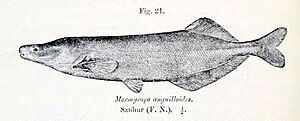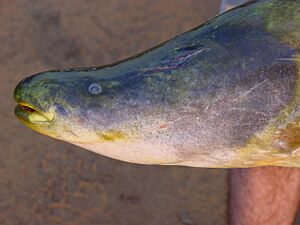Cornish jack facts for kids
Quick facts for kids Cornish jack |
|
|---|---|
 |
|
| Conservation status | |
| Scientific classification | |
| Synonyms | |
|
The Cornish jack, also known as Mormyrops anguilloides, is a special type of fish. It belongs to a family called Mormyridae, which are known as weakly electric fish. This means they can create small amounts of electricity! You can find the Cornish jack in calm waters across much of Sub-Saharan Africa.
This fish is the biggest in its family. It hunts at night in groups, looking for smaller fish. It uses its electric abilities to find food and talk to other fish in its group. People also like to catch the Cornish jack for food because it's big and tastes good.
The name "Cornish jack" probably came from early European settlers. They thought this fish looked a bit like the young of the Northern pike, which is sometimes called a "jack" in England. It's also sometimes called "African carp", but that name is used for a few other fish species too.
Contents
Where the Cornish Jack Lives
The Cornish jack lives in many different places. You can find it in the White Nile river and around Lake Albert. It also lives in rivers and lakes from Senegal all the way to Chad, and in rivers in Cameroon. You can also find it in smaller rivers along the coast in the Guinean area.
This fish is also common in the big Congo River basin. It lives in Lakes Malawi and Tanganyika, and in the Volta River basin. You can also find it in the Shebelle River and the Jubba River. In southern Africa, it mostly lives in the middle and lower parts of the Zambezi river, and in the Buzi and Pungwe Rivers.
This type of fish lives near the bottom of the water. It prefers warm, fresh water, usually between 22 and 24 °C (72 and 75 °F). Young Cornish jacks like to stay in shallow areas near the edges of the water. Adult fish prefer deep, calm spots. They often hide between big rocks or under ledges, away from strong currents. They can also be found under floating plant mats, like Salvinia, and in river mouths in Lake Kariba.
What the Cornish Jack Looks Like
The Cornish jack has a long body and head. Its head is almost twice as long as it is tall. The front of its head is smooth and flat. Its snout is rounded and nearly as wide as its head. The mouth is at the very front of its head, with the upper jaw slightly longer than the lower. Both jaws have a single row of small, pointed teeth.
The eyes of the Cornish jack are very tiny. They are located in the front third of its head. Its gill openings are small and slanted. The dorsal (top) and anal fins (bottom) are placed far back on its body. The caudal fin (tail fin) is fairly small and forked, with rounded parts. The male fish's anal fin is different from the female's. It has longer rays and a noticeable curve in the front half.
The fish has small scales. There are about 85 to 100 scales along its lateral line (a special line of sensory scales). Its color is gray on top and lighter, silvery-white underneath. It often has a shiny bronze or yellow look. Young Cornish jacks are darker, appearing grayish-blue or brown. The exact number of scales, fin rays, and bones can be different depending on where the fish lives. Cornish jacks are the largest fish in their family. They can grow up to 1.5 meters (about 5 feet) long and weigh as much as 15 kilograms (about 33 pounds)!
How the Cornish Jack Lives
Like other mormyrids, Cornish jacks have a special electric organ. They use it to create weak pulses of electricity. This helps them find their way around, locate food, and even talk to each other. They have special cells that can sense electricity. These cells help them detect changes in the electric field around their body. This way, they can figure out the size, distance, and type of objects nearby.
Feeding Habits
Adult Cornish jacks mainly eat other fish. For example, in the Bia River, fish living in lakes mostly eat tilapia. However, what they eat can change with the seasons. Fish living in rivers eat both fish and crustaceans (like crabs or shrimp). Young Cornish jacks mostly eat shrimp and aquatic insect larvae (baby insects). Larger young fish, about 17 cm (7 inches) long, also eat small cichlids, minnows, and labeos. In the past, people thought Cornish jacks ate rotting stuff. This was because they gathered around human camps where a lot of refuse (trash) was thrown into the water.
Scientists have watched Cornish jacks in Lake Malawi. They form groups of 2 to 10 fish that stay together. During the day, the group hides in caves. At night, they hunt for cichlids over rocky reefs. They will go up to 20 m (66 ft) away from their hiding spot. Sometimes, a single fish will leave the group for a short time after catching a cichlid.
When a Cornish jack finds something it might want to eat, it gets close, usually within 1–20 cm (0.39–7.87 in). Then it stops and sends out regular electric pulses every 20 to 40 milliseconds. This "stationary probing" helps the fish guess the size of its prey. They prefer to target smaller cichlids. After a few seconds, they might strike. During the strike, the electric pulses get faster, happening every 18 to 20 milliseconds. Often, the cichlid they are targeting doesn't move much before being caught. This suggests they don't even know the predator is there!
Cornish jacks that hunt in groups catch more prey. They also have more successful attacks than fish hunting alone. However, it's not fully clear why group hunting helps so much. The fish don't share their food, and sometimes one fish even steals prey from another. One idea is that it's more efficient when several predators attack the same prey fish at almost the same time.
Communication
The electrical pulses of Cornish jacks are like their unique voices. Differences in these pulses might help them recognize each other. This helps them keep their groups together. Fish in a group will adjust their electric pulses. They make sure their pulses happen 18 to 20 milliseconds after each other. This "echo response" is common in mormyrids. It's very strong in Cornish jacks and helps them avoid electrical interference with other fish. Hunting groups of Cornish jacks have also been seen making synchronized bursts of electric pulses. These bursts last 1 to 2.5 seconds and happen every few minutes. Scientists think these bursts might be signals to recognize each other as a group.
Reproduction and Life Cycle
The Cornish jack lays eggs, which means it is oviparous. It spawns (lays eggs) in the summer, during the rainy season. In the upper Ogun River, Cornish jacks are very common at the start and middle of the yearly flood. This suggests they travel upstream to breed. They then move back downstream when the water level drops. Female fish lay their eggs in batches. They can carry 25,000 or more eggs at a time. In the Baoulé River, these fish become adults when they are at least 34.6 cm (13.6 in) long. They can live for eight years or even longer.
Cornish Jack and Humans
The Cornish jack is a popular fish for people who like to go fishing. It's also caught by spearfishermen. Because their mouths are quite small, people often use thin fillets of fish, worms, or crabs as bait. They can be caught with light fishing gear because they are not known for fighting hard when caught.
The meat of the Cornish jack is highly valued. In fact, one of its old scientific names, Mormyrops deliciosus, means "delicious" because of its taste! A person named Theodore Gill wrote in 1902 that it was mostly fished for at dawn and sunset. He also noted that a 5-foot (1.5 m) fish could sell for 25 francs in Boma.




